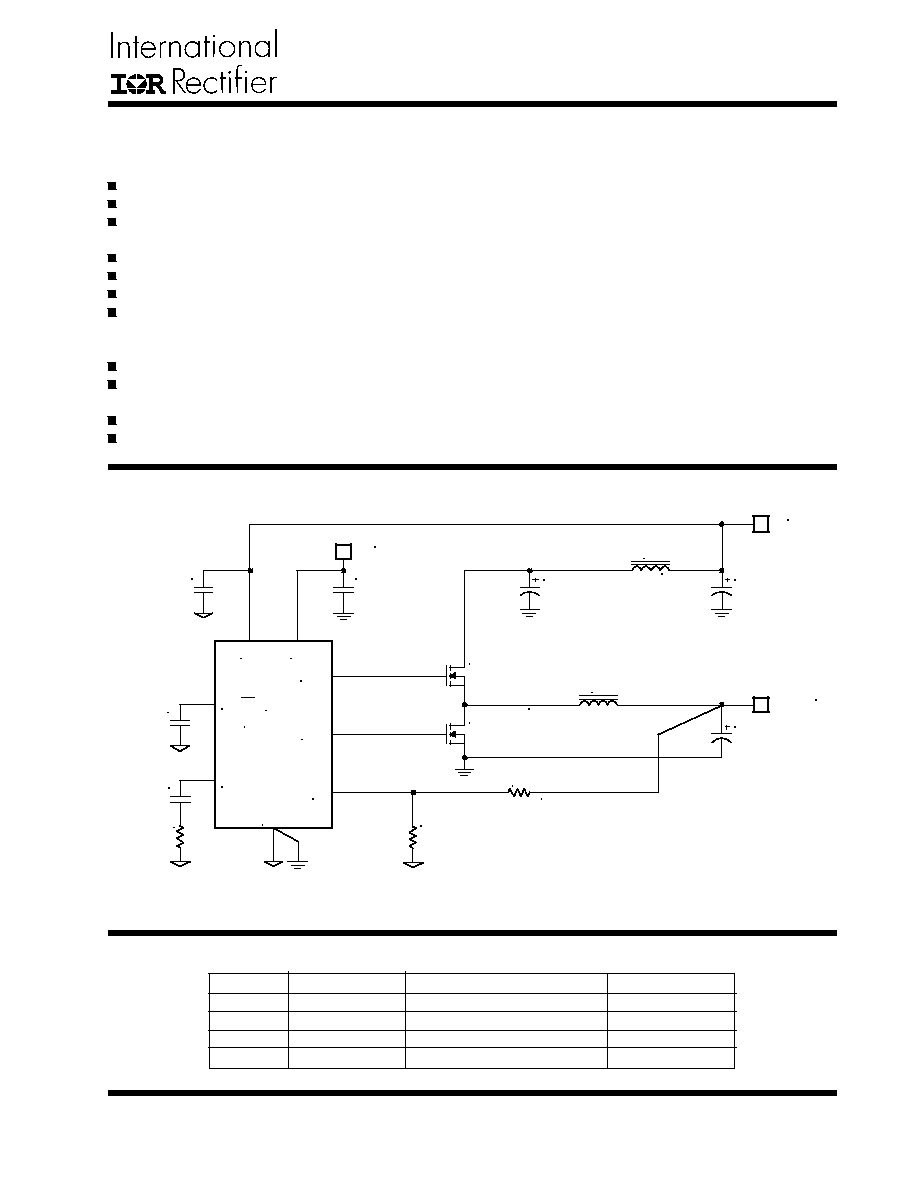
IRU3037 / IRU3037A
1
Rev. 2.8
03/10/03
www.irf.com
TYPICAL APPLICATION
DESCRIPTION
The IRU3037 controller IC is designed to provide a low
cost synchronous Buck regulator for on-board DC to DC
converter applications. With the migration of today's ASIC
products requiring low supply voltages such as 1.8V and
lower, together with currents in excess of 3A, traditional
linear regulators are simply too lossy to be used when
input supply is 5V or even in some cases with 3.3V
input supply. The IRU3037 together with dual N-channel
MOSFETs such as IRF7313, provide a low cost solution
for such applications. This device features an internal
200KHz oscillator (400KHz for "A" version), under-volt-
age lockout for both Vcc and Vc supplies, an external
programmable soft-start function as well as output un-
der-voltage detection that latches off the device when an
output short is detected.
Synchronous Controller in 8-Pin Package
Operating with single 5V or 12V supply voltage
Internal 200KHz Oscillator
(400KHz for IRU3037A)
Soft-Start Function
Fixed Frequency Voltage Mode
500mA Peak Output Drive Capability
Protects the output when control FET is shorted
PACKAGE ORDER INFORMATION
FEATURES
8-PIN SYNCHRONOUS PWM CONTROLLER
APPLICATIONS
DDR memory source sink Vtt application
Low cost on-board DC to DC such as 5V to 3.3V,
2.5V or 1.8V
Graphic Card
Hard Disk Drive
T
A
(∞C)
DEVICE PACKAGE FREQUENCY
0 To 70
IRU3037CF 8-Pin Plastic TSSOP (F) 200KHz
0 To 70
IRU3037CS 8-Pin Plastic SOIC NB (S) 200KHz
0 To 70
IRU3037ACF 8-Pin Plastic TSSOP (F) 400KHz
0 To 70
IRU3037ACS 8-Pin Plastic SOIC NB (S) 400KHz
Data Sheet No. PD94173
Figure 1 - Typical application of IRU3037 or IRU3037A.
IRU3037
U1
Vcc
Vc
HDrv
LDrv
Fb
Gnd
Comp
SS/SD
C3
1uF
C4
1uF
C8
0.1uF
C9
2200pF
R4
24k
Q1
1/2 of IRF7313
Q2
1/2 of IRF7313
R5
1.24K, 1%
R3
249, 1%
L2
D05022P-562, 5.6uH, 5.3A
L1
1uH
C2
10TPB100M,
100uF, 55m
V
C1
47uF
1.5V/5A
C7
2x 6TPC150M,
150uF, 40m
V
12V
5V

2
Rev. 2.8
05/10/04
IRU3037 / IRU3037A
www.irf.com
ABSOLUTE MAXIMUM RATINGS
Vcc Supply Voltage .................................................. 25V
Vc Supply Voltage ...................................................... 30V (not rated for inductive load)
Storage Temperature Range ...................................... -65∞C To 150∞C
Operating Junction Temperature Range ..................... 0∞C To 125∞C
CAUTION: Stresses above those listed in "Absolute Maximum Ratings" may cause permanent damage to the device.
PARAMETER
SYM TEST CONDITION
MIN TYP MAX
UNITS
Reference Voltage
Fb Voltage
Fb Voltage Line Regulation
UVLO
UVLO Threshold - Vcc
UVLO Hysteresis - Vcc
UVLO Threshold - Vc
UVLO Hysteresis - Vc
UVLO Threshold - Fb
UVLO Hysteresis - Fb
Supply Current
Vcc Dynamic Supply Current
Vc Dynamic Supply Current
Vcc Static Supply Current
Vc Static Supply Current
Soft-Start Section
Charge Current
IRU3037
IRU3037A
5<Vcc<12
Supply Ramping Up
Supply Ramping Up
Fb Ramping Down (IRU3037)
(IRU3037A)
Freq=200KHz, C
L
=1500pF
Freq=200KHz, C
L
=1500pF
SS=0V
SS=0V
SS=0V
1.225
0.784
4.0
3.1
0.4
0.3
2
2
1
0.5
-10
1.250
0.800
0.2
4.2
0.25
3.3
0.2
0.6
0.4
0.1
5
7
3.3
1
-20
1.275
0.816
0.35
4.4
3.5
0.8
0.5
8
10
6
4.5
-30
V
%
V
V
V
V
V
V
mA
mA
mA
mA
m
A
V
FB
L
REG
UVLO Vcc
UVLO Vc
UVLO Fb
Dyn Icc
Dyn Ic
I
CCQ
I
CQ
SS
IB
JA
=160
∞
C/W
JA
=124
∞
C/W
Fb
Vcc
LDrv
Gnd
HDrv
Vc
Comp
SS/SD
4
3
2
1
5
6
7
8
Fb
Vcc
LDrv
Gnd
SS/SD
Comp
Vc
HDrv
4
3
2
1
5
6
7
8
ELECTRICAL SPECIFICATIONS
Unless otherwise specified, these specifications apply over Vcc=5V, Vc=12V and T
A
=0 to 70∞C. Typical values refer
to T
A
=25∞C. Low duty cycle pulse testing is used which keeps junction and case temperatures equal to the ambient
temperature.
PACKAGE INFORMATION
8-PIN PLASTIC TSSOP (F) 8-PIN PLASTIC SOIC (S)

IRU3037 / IRU3037A
3
Rev. 2.8
03/10/03
www.irf.com
PARAMETER
SYM TEST CONDITION
MIN TYP MAX
UNITS
PIN DESCRIPTIONS
This pin is connected directly to the output of the switching regulator via resistor divider to
provide feedback to the Error amplifier.
This pin provides biasing for the internal blocks of the IC as well as power for the low side
driver. A minimum of 1
m
F, high frequency capacitor must be connected from this pin to
ground to provide peak drive current capability.
Output driver for the synchronous power MOSFET.
This pin serves as the ground pin and must be connected directly to the ground plane. A
high frequency capacitor (0.1 to 1
m
F) must be connected from V5 and V12 pins to this pin
for noise free operation.
Output driver for the high side power MOSFET. Connect a diode, such as BAT54 or 1N4148,
from this pin to ground for the application when the inductor current goes negative (Source/
Sink), soft-start at no load and for the fast load transient from full load to no load.
This pin is connected to a voltage that must be at least 4V higher than the bus voltage of
the switcher (assuming 5V threshold MOSFET) and powers the high side output driver. A
minimum of 1
m
F, high frequency capacitor must be connected from this pin to ground to
provide peak drive current capability.
Compensation pin of the error amplifier. An external resistor and capacitor network is
typically connected from this pin to ground to provide loop compensation.
This pin provides soft-start for the switching regulator. An internal current source charges
an external capacitor that is connected from this pin to ground which ramps up the output
of the switching regulator, preventing it from overshooting as well as limiting the input
current. The converter can be shutdown by pulling this pin below 0.5V.
Error Amp
Fb Voltage Input Bias Current
Fb Voltage Input Bias Current
Transconductance
Oscillator
Frequency
Ramp-Amplitude Voltage
Output Drivers
Rise Time
Fall Time
Dead Band Time
Max Duty Cycle
Min Duty Cycle
SS=3V, Fb=1V
SS=0V, Fb=1V
IRU3037
IRU3037A
C
L
=1500pF
C
L
=1500pF
Fb=1V, Freq=200KHz
Fb=1.5V
410
180
345
1.225
50
85
0
-0.1
-64
600
200
400
1.25
50
50
150
90
0
830
220
440
1.275
100
100
250
95
m
A
m
A
m
mho
KHz
V
ns
ns
ns
%
%
PIN# PIN SYMBOL PIN DESCRIPTION
1
2
3
4
5
6
7
8
Fb
Vcc
LDrv
Gnd
HDrv
Vc
Comp
SS / SD
I
FB1
I
FB2
g
m
Freq
V
RAMP
T
r
T
f
T
DB
T
ON
T
OFF

4
Rev. 2.8
05/10/04
IRU3037 / IRU3037A
www.irf.com
BLOCK DIAGRAM
Figure 2 - Simplified block diagram of the IRU3037.
THEORY OF OPERATION
Introduction
The IRU3037 is a fixed frequency, voltage mode syn-
chronous controller and consists of a precision refer-
ence voltage, an error amplifier, an internal oscillator, a
PWM comparator, 0.5A peak gate driver, soft-start and
shutdown circuits (see Block Diagram).
The output voltage of the synchronous converter is set
and controlled by the output of the error amplifier; this is
the amplified error signal from the sensed output voltage
and the reference voltage.
This voltage is compared to a fixed frequency linear
sawtooth ramp and generates fixed frequency pulses of
variable duty-cycle, which drives the two N-channel ex-
ternal MOSFETs.The timing of the IC is provided through
an internal oscillator circuit which uses on-chip capaci-
tor to set the oscillation frequency to 200 KHz (400 KHz
for "A" version).
Soft-Start
The IRU3037 has a programmable soft-start to control
the output voltage rise and limit the current surge at the
start-up. To ensure correct start-up, the soft-start se-
quence initiates when the Vc and Vcc rise above their
threshold (3.3V and 4.2V respectively) and generates
the Power On Reset (POR) signal. Soft-start function
operates by sourcing an internal current to charge an
external capacitor to about 3V. Initially, the soft-start func-
tion clamps the E/A's output of the PWM converter. As
the charging voltage of the external capacitor ramps up,
the PWM signals increase from zero to the point the
feedback loop takes control.
Short-Circuit Protection
The outputs are protected against the short-circuit. The
IRU3037 protects the circuit for shorted output by sens-
ing the output voltage (through the external resistor di-
vider). The IRU3037 shuts down the PWM signals, when
the output voltage drops below 0.6V (0.4V for IRU3037A).
The IRU3037 also protects the output from over-voltaging
when the control FET is shorted. This is done by turning
on the sync FET with the maximum duty cycle.
Under-Voltage Lockout
The under-voltage lockout circuit assures that the
MOSFET driver outputs remain in the off state whenever
the supply voltage drops below set parameters. Lockout
occurs if Vc or Vcc fall below 3.3V and 4.2V respec-
tively. Normal operation resumes once Vc and Vcc rise
above the set values.
20uA
64uA Max
POR
Oscillator
Error Amp
Ct
Error Comp
Reset Dom
POR
0.5V
FbLo Comp
3
Vc
HDrv
Vcc
LDrv
Gnd
Vcc
4.0V
Vc
3.5V
0.2V
0.2V
Bias
Generator
3V
1.25V
POR
8
SS/SD
Fb 1
Comp 7
25K
25K
1.25V
3V
2
6
5
R
S
Q
4
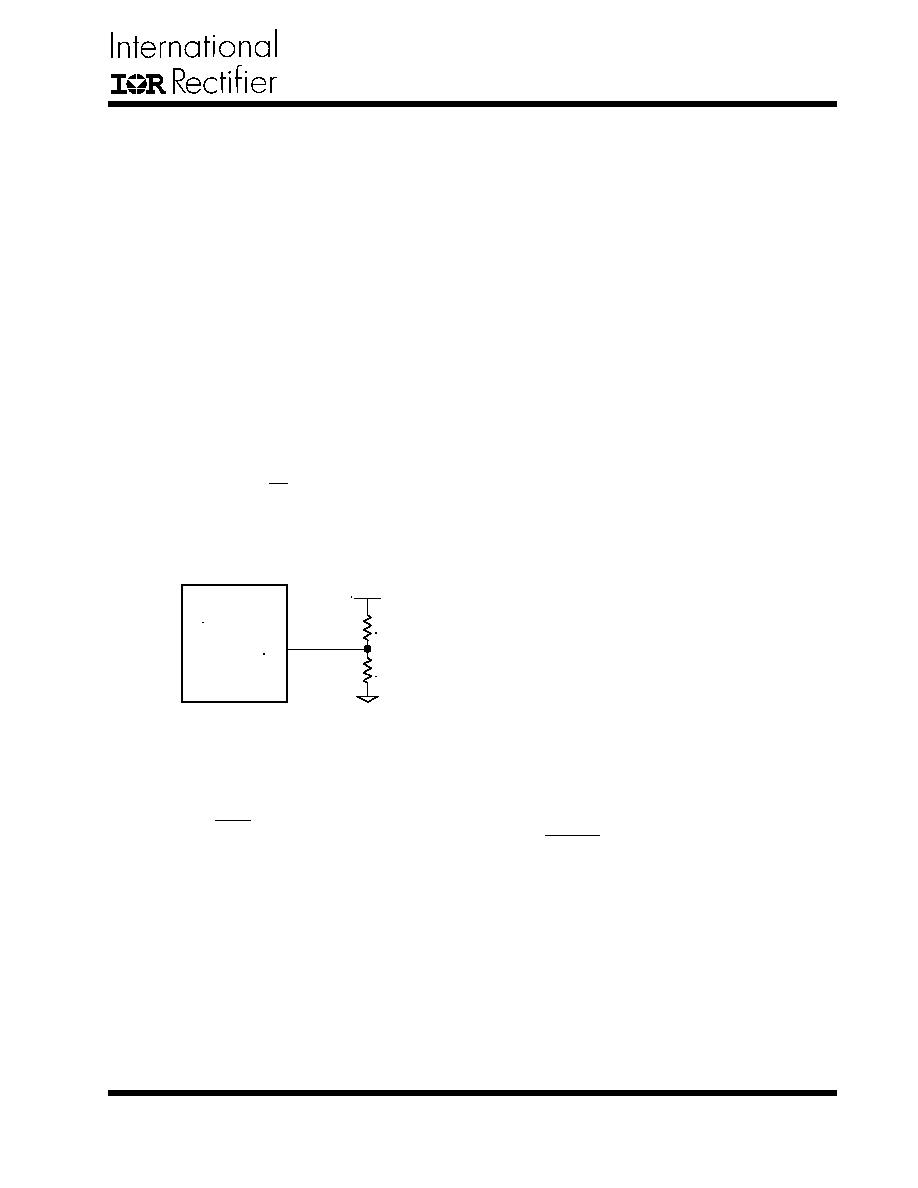
IRU3037 / IRU3037A
5
Rev. 2.8
03/10/03
www.irf.com
Figure 3 - Typical application of the IRU3037 for
programming the output voltage.
APPLICATION INFORMATION
Design Example:
The following example is a typical application for IRU3037,
the schematic is Figure 18 on page 14.
Output Voltage Programming
Output voltage is programmed by reference voltage and
external voltage divider. The Fb pin is the inverting input
of the error amplifier, which is internally referenced to
1.25V (0.8V for IRU3037A). The divider is ratioed to pro-
vide 1.25V at the Fb pin when the output is at its desired
value. The output voltage is defined by using the follow-
ing equation:
When an external resistor divider is connected to the
output as shown in Figure 3.
Equation (1) can be rewritten as:
Choose R
5
= 1K
V
This will result to
R
6
= 1.65K
V
If the high value feedback resistors are used, the input
bias current of the Fb pin could cause a slight increase
in output voltage. The output voltage set point can be
more accurate by using precision resistor.
Soft-Start Programming
The soft-start timing can be programmed by selecting
the soft start capacitance value. The start up time of the
converter can be calculated by using:
Where:
C
SS
is the soft-start capacitor (
m
F)
For a start-up time of 7.5ms, the soft-start capacitor will
be 0.1
m
F. Choose a ceramic capacitor at 0.1
m
F.
Shutdown
The converter can be shutdown by pulling the soft-start
pin below 0.5V. The control MOSFET turns off and the
synchronous MOSFET turns on during shutdown.
Boost Supply Vc
To drive the high-side switch it is necessary to supply a
gate voltage at least 4V greater than the bus voltage.
This is achieved by using a charge pump configuration
as shown in Figure 18. The capacitor is charged up to
approximately twice the bus voltage. A capacitor in the
range of 0.1
m
F to 1
m
F is generally adequate for most
applications. In application, when a separate voltage
source is available the boost circuit can be avoided as
shown in Figure 1.
Input Capacitor Selection
The input filter capacitor should be based on how much
ripple the supply can tolerate on the DC input line. The
larger capacitor, the less ripple expected but consider
should be taken for the higher surge current during the
power-up. The IRU3037 provides the soft-start function
which controls and limits the current surge. The value of
the input capacitor can be calculated by the following
formula:
Where:
C
IN
is the input capacitance (
m
F)
I
IN
is the input current (A)
D
t is the turn on time of the high-side switch (
m
s)
D
V is the allowable peak to peak voltage ripple (V)
Fb
IRU3037
V
OUT
R
5
R
6
t
START
= 75
3
Css (ms) ---(2)
V
IN
= 5V
V
OUT
= 3.3V
I
OUT
= 4A
D
V
OUT
= 100mV
f
S
= 200KHz
R
6
= R
5
3
- 1
V
OUT
V
REF
( )
V
OUT
= V
REF
3
1 +
---(1)
R
6
R
5
( )
C
IN
= ---(3)
I
IN
3
D
t
D
V
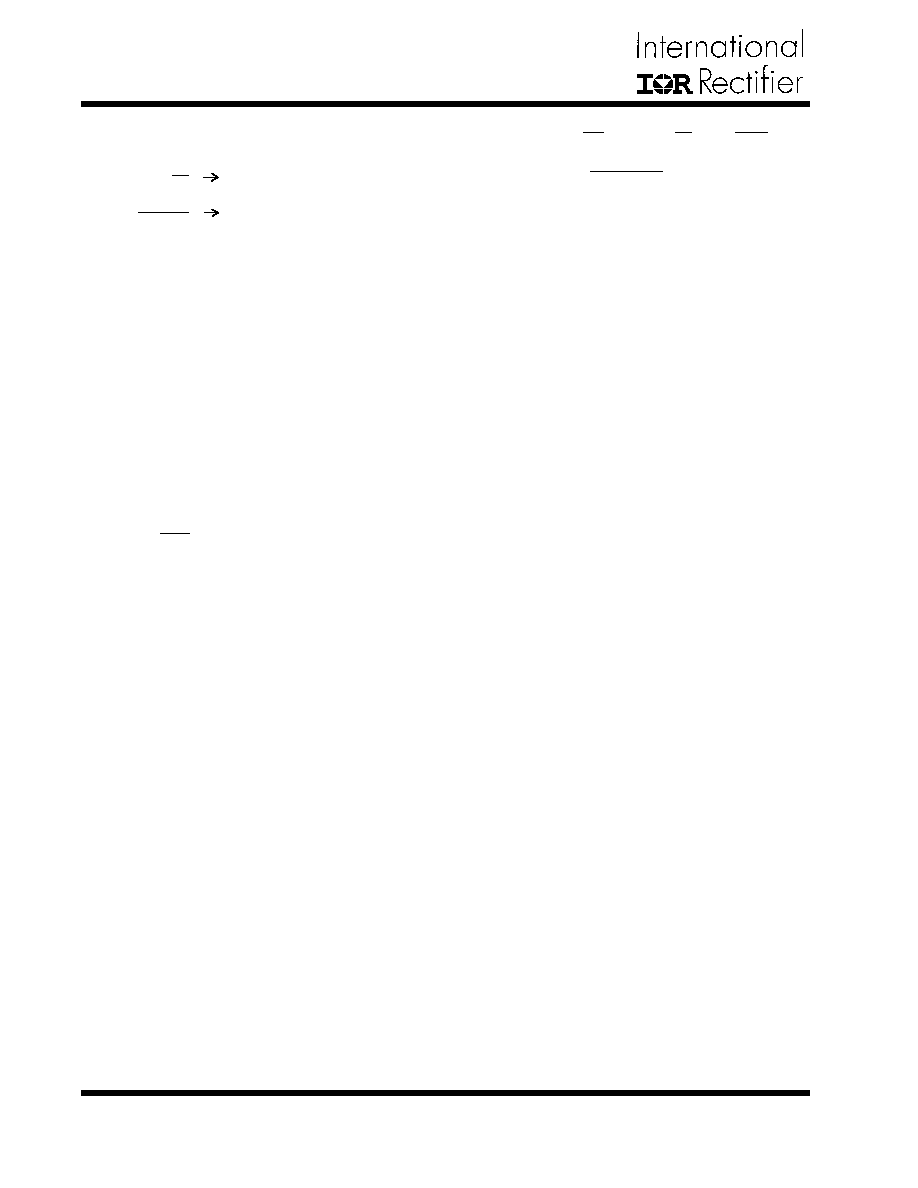
6
Rev. 2.8
05/10/04
IRU3037 / IRU3037A
www.irf.com
Assuming the following:
By using equation (3), C
IN
= 193.3
m
F
For higher efficiency, low ESR capacitor is recommended.
Choose two 100
m
F capacitors.
The Sanyo TPB series PosCap capacitor 100
m
F, 10V
with 55m
V
ESR is a good choice.
Output Capacitor Selection
The criteria to select the output capacitor is normally
based on the value of the Effective Series Resistance
(ESR). In general, the output capacitor must have low
enough ESR to meet output ripple and load transient
requirements, yet have high enough ESR to satisfy sta-
bility requirements. The ESR of the output capacitor is
calculated by the following relationship:
The Sanyo TPC series, PosCap capacitor is a good
choice. The 6TPC150M 150
m
F, 6.3V has an ESR 40m
V
.
Selecting two of these capacitors in parallel, results to
an ESR of
20m
V
which achieves our low ESR goal.
The capacitor value must be high enough to absorb the
inductor's ripple current. The larger the value of capaci-
tor, the lower will be the output ripple voltage.
Inductor Selection
The inductor is selected based on output power, operat-
ing frequency and efficiency requirements. Low inductor
value causes large ripple current, resulting in the smaller
size, but poor efficiency and high output noise. Gener-
ally, the selection of inductor value can be reduced to
desired maximum ripple current in the inductor (
i). The
optimum point is usually found between 20% and 50%
ripple of the output current.
For the buck converter, the inductor value for desired
operating ripple current can be determined using the fol-
lowing relation:
If
D
i = 20%(I
O
), then the output inductor will be:
The Toko D124C series provides a range of inductors in
different values, low profile suitable for large currents,
10
m
H, 4.2A is a good choice for this application. This
will result to a ripple approximately 14% of output cur-
rent.
Power MOSFET Selection
The IRU3037 uses two N-Channel MOSFETs. The se-
lections criteria to meet power transfer requirements is
based on maximum drain-source voltage (V
DSS
), gate-
source drive voltage (V
GS
), maximum output current, On-
resistance R
DS(ON)
and thermal management.
The MOSFET must have a maximum operating voltage
(V
DSS
) exceeding the maximum input voltage (V
IN
).
The gate drive requirement is almost the same for both
MOSFETs. Logic-level transistor can be used and cau-
tion should be taken with devices at very low V
GS
to pre-
vent undesired turn-on of the complementary MOSFET,
which results a shoot-through current.
The total power dissipation for MOSFETs includes con-
duction and switching losses. For the Buck converter
the average inductor current is equal to the DC load cur-
rent. The conduction loss is defined as:
The R
DS(ON)
temperature dependency should be consid-
ered for the worst case operation. This is typically given
in the MOSFET data sheet. Ensure that the conduction
losses and switching losses do not exceed the package
ratings or violate the overall thermal budget.
2
2
P
COND
(Upper Switch) = I
LOAD
3
R
DS(ON)
3
D
3
q
P
COND
(Lower Switch) = I
LOAD
3
R
DS(ON)
3
(1 - D)
3
q
q
= R
DS(ON)
Temperature Dependency
Where:
D
V
O
= Output Voltage Ripple
D
I
O
= Output Current
D
V
O
=100mV and
D
I
O
=4A
Results to ESR=25m
V
ESR
[
---(4)
D
V
O
D
I
O
Where:
V
IN
= Maximum Input Voltage
V
OUT
= Output Voltage
i = Inductor Ripple Current
f
S
= Switching Frequency
t = Turn On Time
D = Duty Cycle
V
IN
- V
OUT
= L
3
;
D
t = D
3
; D =
D
i
D
t
1
f
S
V
OUT
V
IN
L = (V
IN
- V
OUT
)
3
---(5)
V
OUT
V
IN
3D
i
3
f
S
L = 7
m
H
D
t = D
3
D
t = 3.3
m
s
1
f
S
I
IN
=
I
IN
= 2.93A
D
V = 1%(V
IN
), Efficiency(
h
) = 90%
V
O
3
I
O
h 3
V
IN
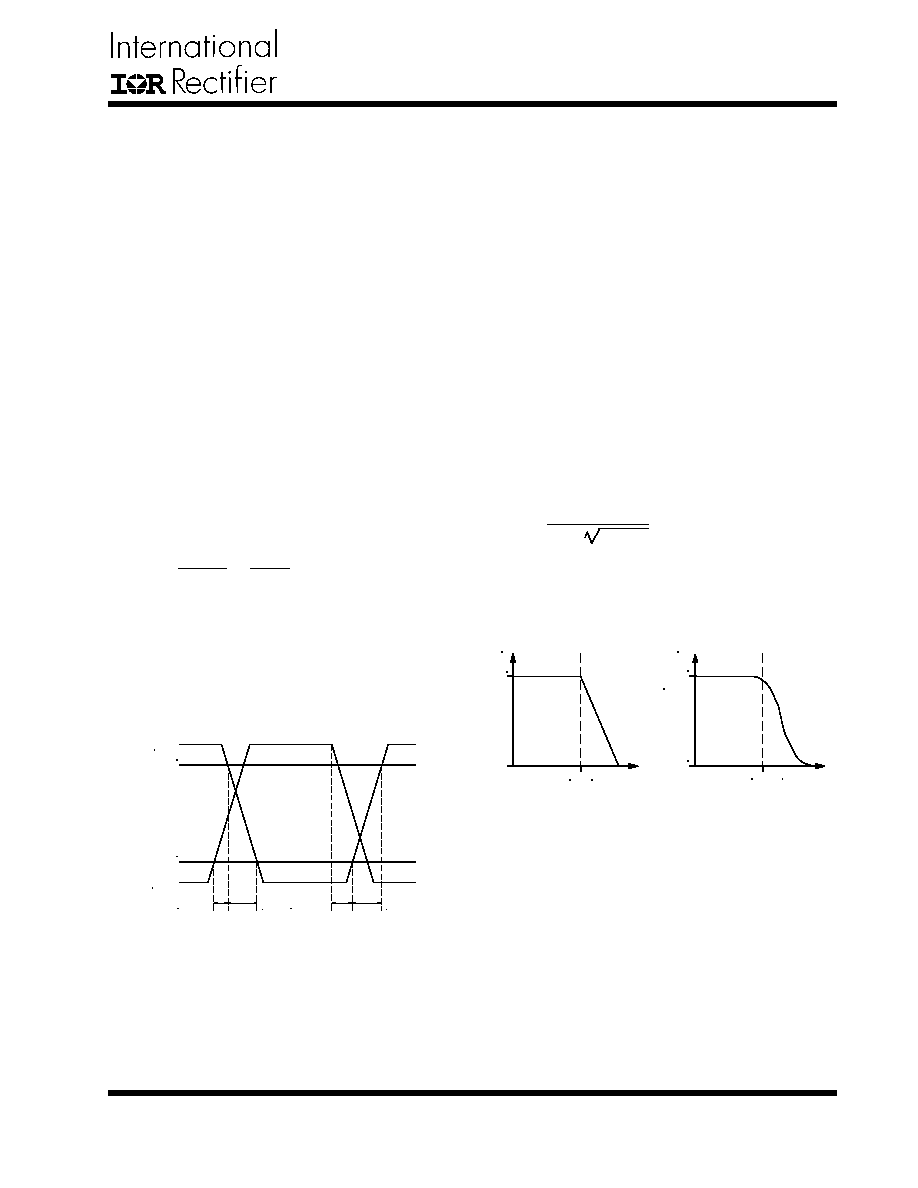
IRU3037 / IRU3037A
7
Rev. 2.8
03/10/03
www.irf.com
For this design, IRF7301 is a good choice. The device
provides low on-resistance in a compact SOIC 8-Pin
package.
The IRF7301 has the following data:
The total conduction losses will be:
The switching loss is more difficult to calculate, even
though the switching transition is well understood. The
reason is the effect of the parasitic components and
switching times during the switching procedures such
as turn-on / turnoff delays and rise and fall times. With a
linear approximation, the total switching loss can be ex-
pressed as:
The switching time waveform is shown in figure 4.
Figure 4 - Switching time waveforms.
From IRF7301 data sheet we obtain:
These values are taken under a certain condition test.
For more detail please refer to the IRF7301 data sheet.
By using equation (6), we can calculate the switching
losses.
Feedback Compensation
The IRU3037 is a voltage mode controller; the control
loop is a single voltage feedback path including error
amplifier and error comparator. To achieve fast transient
response and accurate output regulation, a compensa-
tion circuit is necessary. The goal of the compensation
network is to provide a closed loop transfer function with
the highest 0dB crossing frequency and adequate phase
margin (greater than 45
8
).
The output LC filter introduces a double pole, ≠40dB/
decade gain slope above its corner resonant frequency,
and a total phase lag of 180
8
(see Figure 5). The Reso-
nant frequency of the LC filter expressed as follows:
Figure 5 shows gain and phase of the LC filter. Since we
already have 180
8
phase shift just from the output filter,
the system risks being unstable.
Figure 5 - Gain and phase of LC filter.
The IRU3037's error amplifier is a differential-input
transconductance amplifier. The output is available for
DC gain control or AC phase compensation.
The E/A can be compensated with or without the use of
local feedback. When operated without local feedback
the transconductance properties of the E/A become evi-
dent and can be used to cancel one of the output filter
poles. This will be accomplished with a series RC circuit
from Comp pin to ground as shown in Figure 6.
V
DSS
= 20V
I
D
= 5.2A
R
DS(ON)
= 0.05
V
Where:
V
DS(OFF)
= Drain to Source Voltage at off time
t
r
= Rise Time
t
f
= Fall Time
T = Switching Period
I
LOAD
= Load Current
t
r
= 42ns
t
f
= 51ns
P
SW
= 0.186W
P
CON(TOTAL)
=P
CON
(Upper Switch)+P
CON
(Lower Switch)
P
CON(TOTAL)
= I
LOAD
3
R
DS(ON)
3
q
2
q
= 1.5 according to the IRF7301 data sheet for
150
8
C junction temperature
P
CON(TOTAL)
= 1.2W
F
LC
= ---(7)
1
2
p3
L
O
3
C
O
P
SW
=
I
LOAD
---(6)
t
r
+
t
f
T
V
DS(OFF)
2
3
3
V
DS
V
GS
10%
90%
t
d
(ON)
t
d
(OFF)
t
r
t
f
Gain
F
LC
0dB
Phase
0
8
F
LC
-180
8
Frequency
Frequency
-40dB/decade
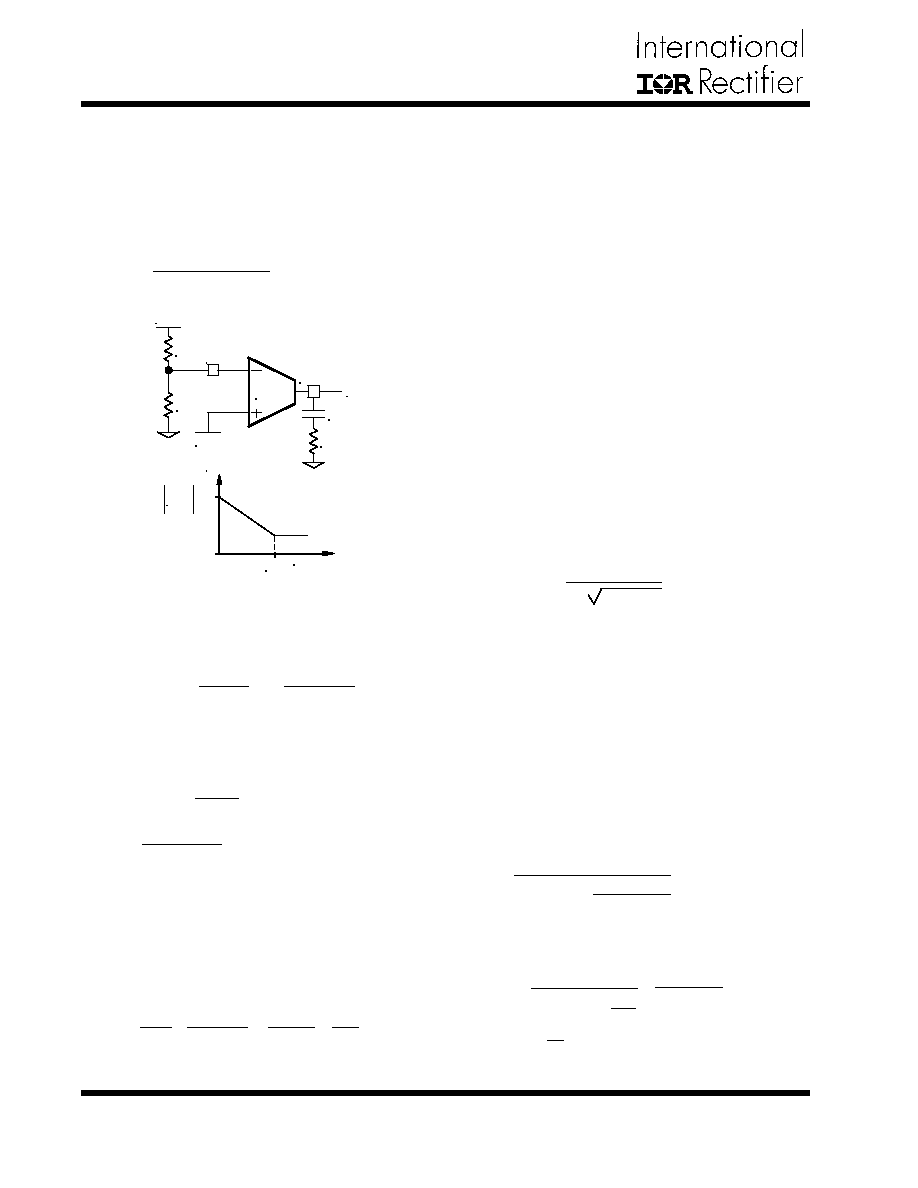
8
Rev. 2.8
05/10/04
IRU3037 / IRU3037A
www.irf.com
Note that this method requires that the output capacitor
should have enough ESR to satisfy stability requirements.
In general the output capacitor's ESR generates a zero
typically at 5KHz to 50KHz which is essential for an
acceptable phase margin.
The ESR zero of the output capacitor expressed as fol-
lows:
Figure 6 - Compensation network without local
feedback and its asymptotic gain plot.
The transfer function (Ve / V
OUT
) is given by:
The (s) indicates that the transfer function varies as a
function of frequency. This configuration introduces a gain
and zero, expressed by:
The gain is determined by the voltage divider and E/A's
transconductance gain.
First select the desired zero-crossover frequency (Fo):
Use the following equation to calculate R
4
:
Where:
V
IN
= Maximum Input Voltage
V
OSC
= Oscillator Ramp Voltage
Fo = Crossover Frequency
F
ESR
= Zero Frequency of the Output Capacitor
F
LC
= Resonant Frequency of the Output Filter
R
5
and R
6
= Resistor Dividers for Output Voltage
Programming
g
m
= Error Amplifier Transconductance
This results to R
4
=104.4K
V
. Choose R
4
=105K
V
To cancel one of the LC filter poles, place the zero be-
fore the LC filter resonant frequency pole:
Using equations (11) and (13) to calculate C
9
, we get:
One more capacitor is sometimes added in parallel with
C
9
and R
4
. This introduces one more pole which is mainly
used to supress the switching noise. The additional pole
is given by:
The pole sets to one half of switching frequency which
results in the capacitor C
POLE:
For:
V
IN
= 5V
V
OSC
= 1.25V
Fo = 30KHz
F
ESR
= 26.52KHz
F
LC
= 2.9KHz
R
5
= 1K
R
6
= 1.65K
g
m
= 600
m
mho
C
9
= 698pF
Choose C
9
= 680pF
F
P
=
2
p
3
R
4
3
C
9
3
C
POLE
C
9
+ C
POLE
1
V
OUT
V
REF
R
5
R
6
R
4
C
9
Ve
E/A
F
Z
H(s) dB
Frequency
Gain(dB)
Fb
Comp
F
ESR
= ---(8)
1
2
p
3
ESR
3
Co
F
Z
75%F
LC
F
Z
0.75
3
---(13)
1
2
p
L
O
3
C
O
For:
Lo = 10
m
H
Co = 300
m
F
F
Z
= 2.17KHz
R
4
= 86.6K
V
Fo > F
ESR
and F
O
[
(1/5 ~ 1/10)
3
f
S
H(s) = g
m
3 3
---(9)
(
)
R
5
R
6
+ R
5
1 + sR
4
C
9
sC
9
F
Z
= ---(11)
1
2
p3
R
4
3
C
9
|H(s)| = g
m
3
3
R
4
---(10)
R
5
R
6
3
R
5
R
4
=
---(12)
V
OSC
V
IN
Fo
3
F
ESR
F
LC2
R
5
+ R
6
R
5
1
g
m
3
3
3
C
POLE
=
p3
R
4
3
f
S
-
1
for F
P
<<
f
S
2
1
C
9
1
p3
R
4
3
f
S
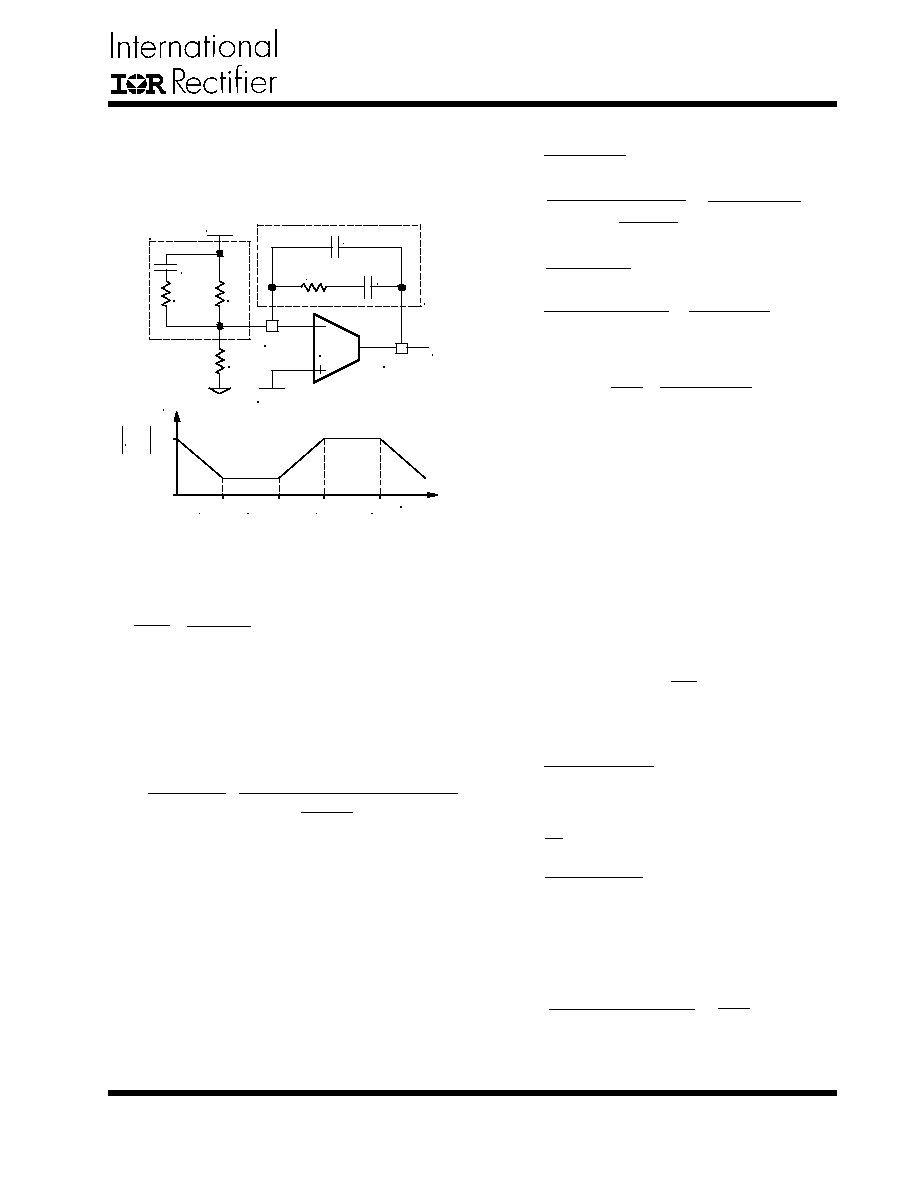
IRU3037 / IRU3037A
9
Rev. 2.8
03/10/03
www.irf.com
For a general solution for unconditionally stability for any
type of output capacitors, in a wide range of ESR values
we should implement local feedback with a compensa-
tion network. The typically used compensation network
for voltage-mode controller is shown in Figure 7.
Figure 7 - Compensation network with local
feedback and its asymptotic gain plot.
In such configuration, the transfer function is given by:
The error amplifier gain is independent of the transcon-
ductance under the following condition:
By replacing Z
IN
and Z
f
according to Figure 7, the trans-
former function can be expressed as:
As known, transconductance amplifier has high imped-
ance (current source) output, therefore, consider should
be taken when loading the E/A output. It may exceed its
source/sink output current capability, so that the ampli-
fier will not be able to swing its output voltage over the
necessary range.
The compensation network has three poles and two ze-
ros and they are expressed as follows:
Cross Over Frequency:
The stability requirement will be satisfied by placing the
poles and zeros of the compensation network according
to following design rules. The consideration has been
taken to satisfy condition (14) regarding transconduc-
tance error amplifier.
1) Select the crossover frequency:
Fo < F
ESR
and Fo
[
(1/10 ~ 1/6)
3
f
S
2) Select R
7
, so that R
7
>>
3) Place first zero before LC's resonant frequency pole.
F
Z1
75% F
LC
4) Place third pole at the half of the switching frequency.
C
12
> 50pF
If not, change R
7
selection.
5) Place R
7
in (15) and calculate C
10
:
2
g
m
1 -
g
m
Z
f
1 +
g
m
Z
IN
V
e
V
OUT
=
Where:
V
IN
= Maximum Input Voltage
V
OSC
= Oscillator Ramp Voltage
Lo = Output Inductor
Co = Total Output Capacitors
C
11
=
1
2
p 3
F
Z1
3
R
7
C
12
=
1
2
p 3
R
7
3
F
P3
F
P3
=
f
S
2
C
10
[
3
2
p 3
Lo
3
Fo
3
Co
R
7
V
OSC
V
IN
F
P1
= 0
1
2
p3
C
10
3
(R
6
+ R
8
)
F
Z2
=
1
2
p3
C
10
3
R
6
F
Z1
=
1
2
p3
R
7
3
C
11
F
P3
=
1
C
12
3
C
11
C
12
+C
11
2
p3
R
7
3
1
2
p3
R
7
3
C
12
F
P2
=
1
2
p3
R
8
3
C
10
(
)
V
OUT
V
REF
R
5
R
6
R
8
C
10
C
12
C
11
R
7
Ve
F
Z
1
F
Z
2
F
P
2
F
P
3
E/A
Z
f
Z
IN
Frequency
Gain(dB)
H(s) dB
Fb
Comp
g
m
Z
f
>> 1 and
g
m
Z
IN
>>1 ---(14)
H(s)=
3
(1+sR
7
C
11
)
3
[1+sC
10
(R
6
+R
8
)]
1
sR
6
(C
12
+C
11
)
1+sR
7
3
(1+sR
8
C
10
)
[
(
)]
C
12
3
C
11
C
12
+C
11
F
O
= R
7
3
C
10
3
3
---(15)
V
IN
V
OSC
1
2
p3
Lo
3
Co
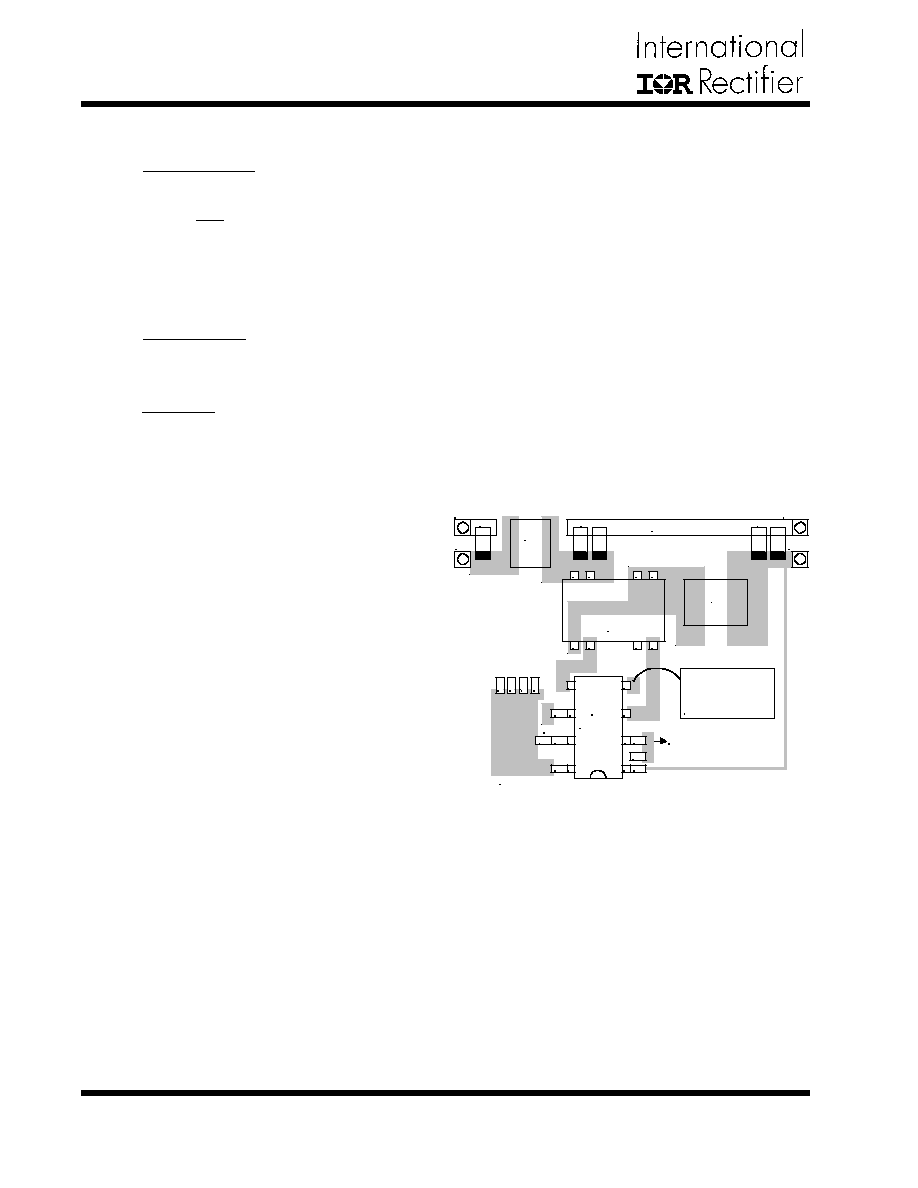
10
Rev. 2.8
05/10/04
IRU3037 / IRU3037A
www.irf.com
6) Place second pole at the ESR zero.
F
P2
= F
ESR
Check if R
8
>
If R
8
is too small, increase R
7
and start from step 2.
7) Place second zero around the resonant frequency.
F
Z2
= F
LC
8) Use equation (1) to calculate R
5
.
These design rules will give a crossover frequency ap-
proximately one-tenth of the switching frequency. The
higher the band width, the potentially faster the load tran-
sient speed. The gain margin will be large enough to
provide high DC-regulation accuracy (typically -5dB to -
12dB). The phase margin should be greater than 45
8
for
overall stability.
IC Quiescent Power Dissipation
Power dissipation for IC controller is a function of ap-
plied voltage, gate driver loads and switching frequency.
The IC's maximum power dissipation occurs when the
IC operating with single 12V supply voltage (Vcc=12V
and Vc
24V) at 400KHz switching frequency and maxi-
mum gate loads.
Figures 9 and 10 show voltage vs. current, when the
gate drivers loaded with 470pF, 1150pF and 1540pF ca-
pacitors. The IC's power dissipation results to an exces-
sive temperature rise. This should be considered when
using IRU3037A for such application.
Layout Consideration
The layout is very important when designing high fre-
quency switching converters. Layout will affect noise
pickup and can cause a good design to perform with
less than expected results.
Start to place the power components, make all the con-
nection in the top layer with wide, copper filled areas.
The inductor, output capacitor and the MOSFET should
be close to each other as possible. This helps to reduce
the EMI radiated by the power traces due to the high
switching currents through them. Place input capacitor
directly to the drain of the high-side MOSFET, to reduce
the ESR replace the single input capacitor with two par-
allel units. The feedback part of the system should be
kept away from the inductor and other noise sources,
and be placed close to the IC. In multilayer PCB use
one layer as power ground plane and have a control cir-
cuit ground (analog ground), to which all signals are ref-
erenced. The goal is to localize the high current path to
a separate loop that does not interfere with the more
sensitive analog control function. These two grounds
must be connected together on the PC board layout at a
single point.
Figure 8 shows a suggested layout for the critical com-
ponents, based on the schematic on page 14.
Figure 8 - Suggested layout.
(Topside shown only)
1
g
m
R
8
=
1
2
p 3
C
10
3
F
P2
R
6
= - R
8
1
2
p 3
C
10
3
F
Z2
R
5
=
3
R
6
V
REF
V
OUT
- V
REF
C
5
D
1
D
2
IRU3037
1
2
3
4
5
6
7
8
1
2
3
4
5
6
7
8
L1
L2
U1
Q1
R4
C4
C9
C8
C3
R5
R6
C1
Vin
C2A, B
C7A, B
Analog Gnd
PGnd
PGnd
Vout
PGnd
D
3
Single Point
Analog Gnd
Connect to
Power Ground plane
Analog Gnd
PGnd
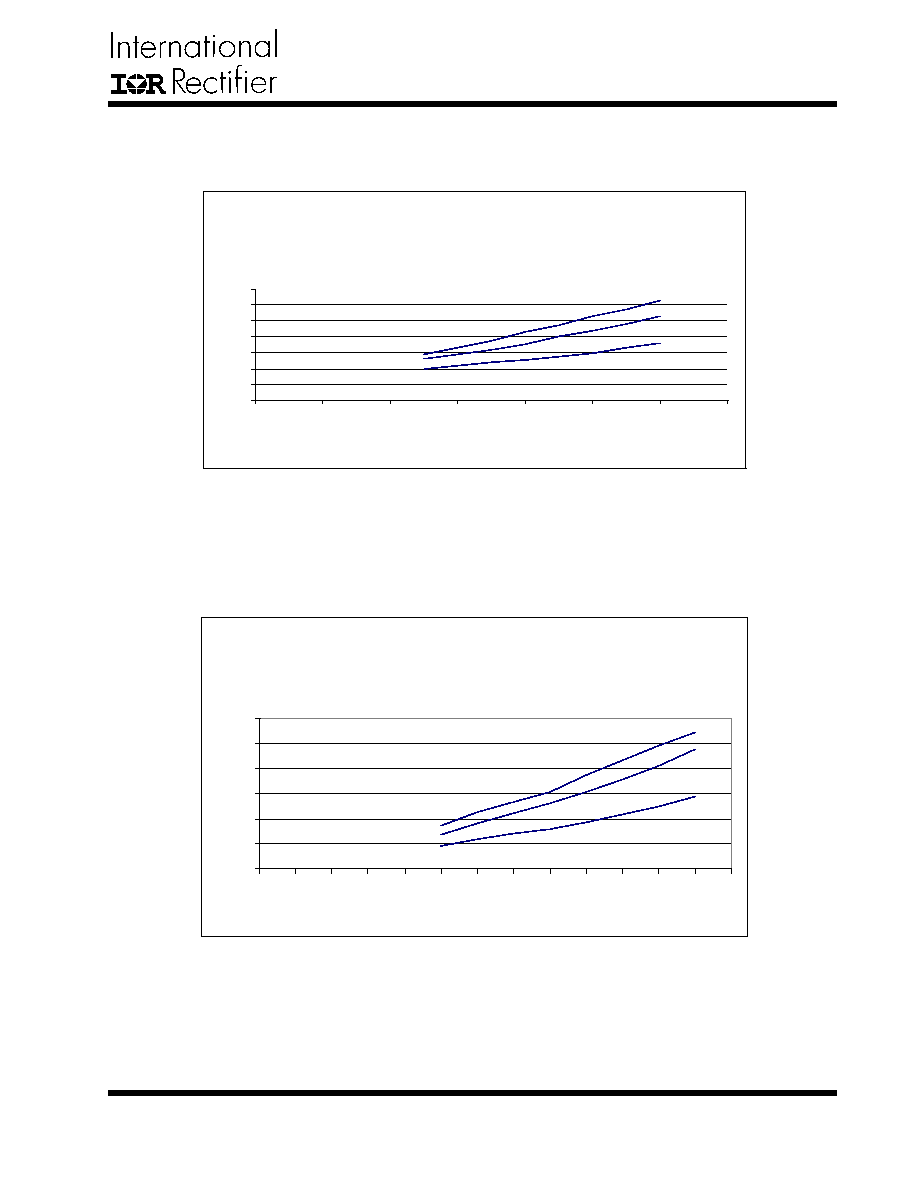
IRU3037 / IRU3037A
11
Rev. 2.8
03/10/03
www.irf.com
TYPICAL PERFORMANCE CHARACTERISTICS
Figure 9 - Vcc vs. Icc
IRU3037A
Vcc vs. Icc
@470PF, 1150PF and 1540PF Gate Load
0
2
4
6
8
10
12
14
0
2
4
6
8
10
12
14
Vcc (V)
Icc (mA)
T
A
= 25
8
C
C
LOAD
=1540pF
C
LOAD
=1150pF
C
LOAD
=470pF
Figure 10 - Vc vs. Ic
IRU3037A
Vc vs. Ic
@470PF, 1150PF and 1540PF Gate Load
0
5
10
15
20
25
30
0
2
4
6
8
10
12
14
16
18
20
22
24
26
Vc (V)
Ic (ma)
T
A
= 25
8
C
C
LOAD
=1540pF
C
LOAD
=1150pF
C
LOAD
=470pF
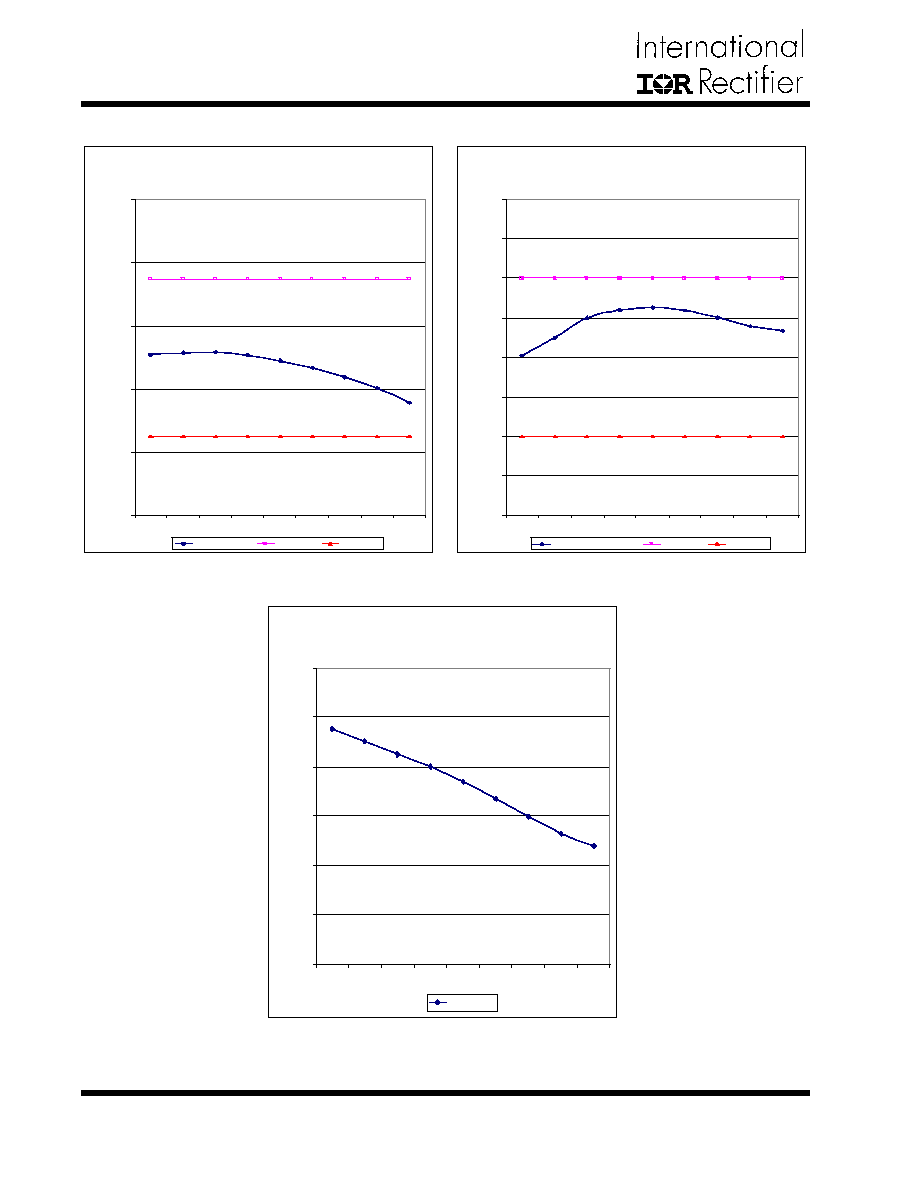
12
Rev. 2.8
05/10/04
IRU3037 / IRU3037A
www.irf.com
TYPICAL PERFORMANCE CHARACTERISTICS
Figure 11 - Output Voltage
Figure 12 - Output Frequency
Figure 13 - Maximum Duty Cycle
I R U 3 0 3 7
O u t p u t V o l t a g e
1 . 2
1 . 2 2
1 . 2 4
1 . 2 6
1 . 2 8
1 . 3
-40∞C
0 ∞ C
+ 5 0 ∞ C
+ 1 0 0 ∞ C
+ 1 5 0 ∞ C
Volts
O u t p u t V o l t a g e
S p e c M a x .
Spec Min.
M a x
I R U 3 0 3 7
O u t p u t F r e q u e n c y
1 6 0
1 7 0
1 8 0
1 9 0
2 0 0
2 1 0
2 2 0
2 3 0
2 4 0
-40∞C
0 ∞ C
+ 5 0 ∞ C
+ 1 0 0 ∞ C
+ 1 5 0 ∞ C
Kilo Hertz
O s c i l l a t i o n F r e q u e n c y
S p e c M a x .
S p e c M i n .
M a x
IRU3037
Maximum Duty Cycle
80.0%
82.0%
84.0%
86.0%
88.0%
90.0%
92.0%
-40∞C
-25∞C
0∞C
+25∞C
+50∞C
+75∞C
+100∞C +125∞C
+150∞C
Percent Duty Cycle
Max Duty Cycle
Min
Min

IRU3037 / IRU3037A
13
Rev. 2.8
03/10/03
www.irf.com
Figure 16 - Transconductance
Figure 15 - Output Frequency
Figure 14 - Output Voltage
Figure 17 - Rise Time and Fall Time
IRU3037 / IRU3037A
Rise Time / Fall Time
CL = 1500pF
0
5
10
15
20
25
30
35
40
45
50
-40∞C
-25∞C
0∞C
+25∞C
+50∞C
+75∞C
+100∞C
nano Seconds
Rise Time
Fall time
IRU3037 / IRU3037A
Transconductance ( GM )
0
100
200
300
400
500
600
700
800
900
1000
-40∞C
-25∞C
0∞C
+25∞C
+50∞C
+75∞C
+100∞C
micro Mho's
Positive load GM
Negative load GM
I R U 3 0 3 7 A
O u t p u t V o l t a g e
7 6 0
7 7 0
7 8 0
7 9 0
8 0 0
8 1 0
8 2 0
-40∞C
- 2 5 ∞ C
0 ∞ C
+ 2 5 ∞ C
+ 5 0 ∞ C
+ 7 5 ∞ C
+ 1 0 0 ∞ C + 1 5 0 ∞ C
milli Volts
O u t p u t V o l t a g e
S p e c M a x .
S p e c M i n .
M a x
Min
I R U 3 0 3 7 A
O u t p u t F r e q u e n c y
3 0 0
3 2 0
3 4 0
3 6 0
3 8 0
4 0 0
4 2 0
4 4 0
4 6 0
- 4 0 ∞ C
-25∞C
0∞C
+ 2 5 ∞ C
+ 5 0 ∞ C
+ 7 5 ∞ C
+ 1 0 0 ∞ C + 1 5 0 ∞ C
Kilo Hertz
O s c i l l a t i o n F r e q u e n c y
S p e c M a x .
S p e c M i n .
M a x
Min
TYPICAL PERFORMANCE CHARACTERISTICS

14
Rev. 2.8
05/10/04
IRU3037 / IRU3037A
www.irf.com
TYPICAL APPLICATION
Single Supply 5V Input
Figure 18 - Typical application of IRU3037 in an on-board DC-DC converter
using a single 5V supply.
IRU3037
U1
Vcc
Vc
HDrv
LDrv
Fb
Gnd
Comp
SS/SD
C3
1uF
C4
1uF
C8
0.1uF
C9
680pF
R4
105K
Q1
1/2 of IRF7301
Q2
1/2 of IRF7301
R5
1K, 1%
R6
1.65K, 1%
L2
D05022P-103, 10uH, 4.3A
L1
1uH
C2
2x 10TPB100ML,
100uF, 55m
V
C1
47uF
Tantalum
3.3V
@ 4A
C7
2x 6TPC150M,
150uF, 40m
V
C5
0.1uF
D1
1N4148
D2
1N4148
D3
1N4148
5V
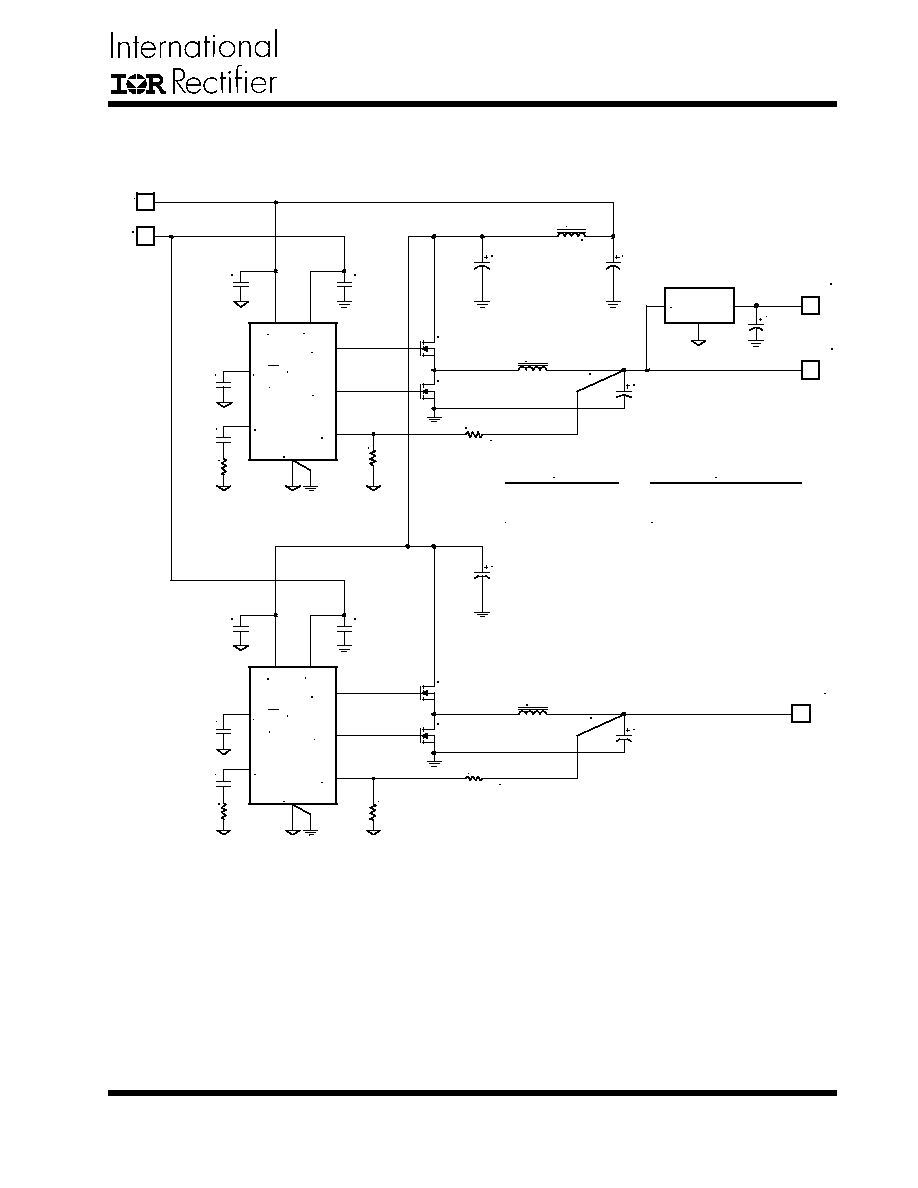
IRU3037 / IRU3037A
15
Rev. 2.8
03/10/03
www.irf.com
Figure 19 - Typical application of IRU3037 or IRU3037A in an on-board DC-DC converter providing the Core,
GTL+, and Clock supplies for the Pentium II microprocessor.
TYPICAL APPLICATION
Dual Supply, 5V Bus and 12V Bias Input
IRU3037
U1
Vcc
Vc
HDrv
LDrv
Fb
Gnd
Comp
SS/SD
Vcc
Vc
HDrv
LDrv
Fb
Gnd
Comp
12V
IRU1206-18
2.5V/2A
1.8V/1A
R3
1K
1%
C3
47uF
C1
47uF
L1
1uH
C2
10TPB100M, 100uF,
55m
V
, 1.5A rms
Q1
1/2 of IRF7752
L2
CTX5-2P, 3.5uH @ 2.5A
Q2
1/2 of IRF7752
R1
1K, 1%
C1
1uF
C4
1uF
C7
0.1uF
C8
2200pF
R2
14K
C10
1uF
C11
1uF
C13
0.1uF
C14
2200pF
R5
14K
R6
1K, 1%
R4
1.65K, 1%
Q4
1/2 of IRF7752
L3
CTX5-1P, 3.4uH @ 2A
Q3
1/2 of IRF7752
C9
10TPB100M, 100uF,
55m
V
, 1.5A rms
3.3V/1.8A
L2
CTX5-2P, 3.5uH @ 2.5A
CTX10-5P, 5.7uH @ 2.5A
C6
6TPB150M, 150uF, 55m
V
(Qty 2)
6TPB150M, 150uF, 55m
V
(Qty 1)
C6
6TPB150M, 150uF, 55m
V
C12
6TPB150M, 150uF, 55m
V
5V
IRU3037
U2
SS/SD

16
Rev. 2.8
05/10/04
IRU3037 / IRU3037A
www.irf.com
TYPICAL APPLICATION
1.8V to 7.5V / 0.5A Boost Converter
Figure 20 - Typical application of IRU3037 as a boost converter.
SS/SD Comp Vc HDrv
Fb
Vcc LDrv Gnd
IRU3037
U1
R2
10K
R3
20K
Vpwr (1.5V Min)
Vc/Vcc
V
OUT
(7.5V / 0.5A)
Gnd
C9
2x 47uF
D1
1N5817
L1
1uH (CoilTronics UP2B-1R0)
C1
2x 68uF
5K, 1%
1K, 1%
C8
1uF
R4
25K
R1
20K
Q2
2N2222
Q1
2N2222
C5
1uF
Q3
IRF7402
C4
0.01uF
C5
0.1uF
C10
100pF
R5
R6
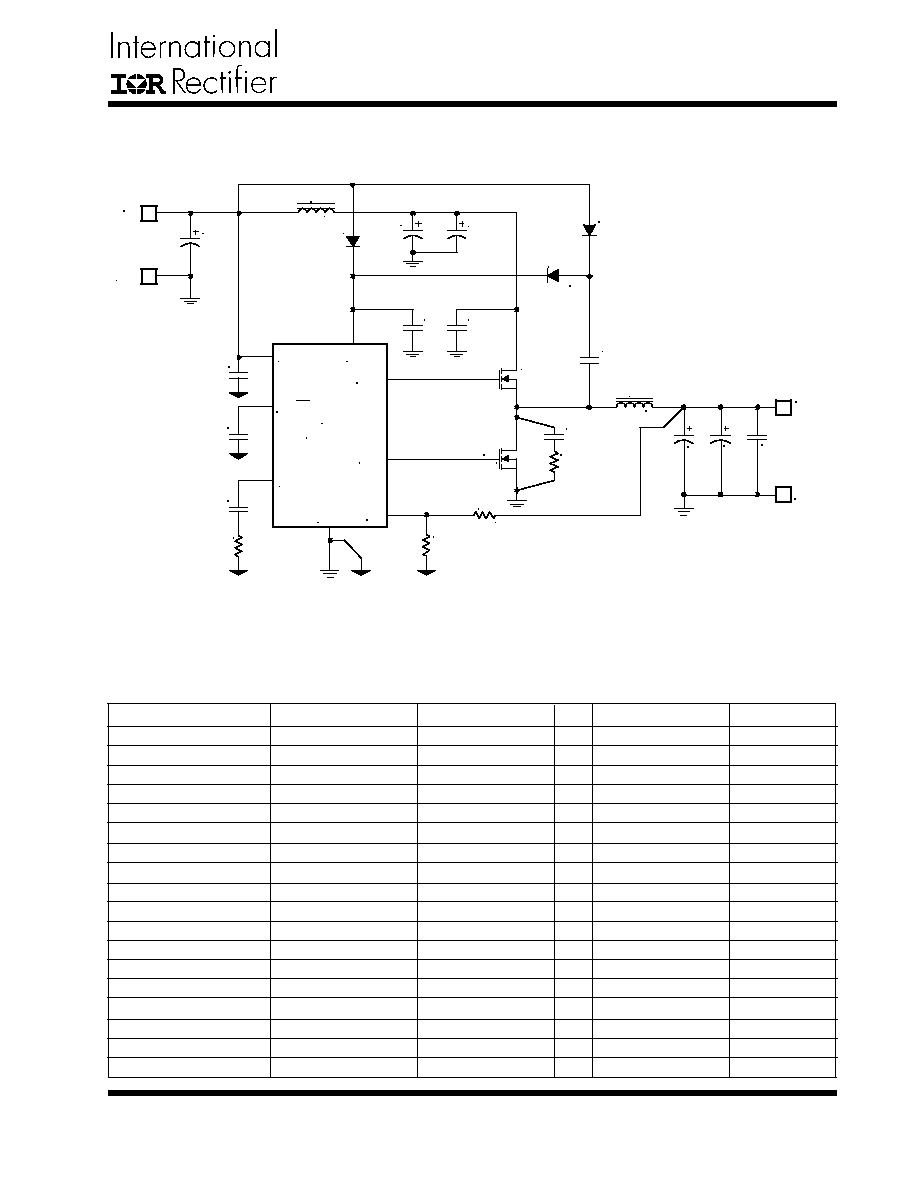
IRU3037 / IRU3037A
17
Rev. 2.8
03/10/03
www.irf.com
DEMO-BOARD APPLICATION
5V or 12V to 3.3V @ 10A
Ref Desig
Description Value Qty
Part# Manuf
1
1
1
3
1
1
1
2
2
2
1
1
1
3
1
1
1
1
Q1
Q2
U1
D1, D2, D4
L1
L2
C1
C2A, C2B
C9B, C9C
C5, C6
C3
C4
C7
C8, C13, C19
R3
R4
R5
R6
MOSFET
MOSFET
Controller
Diode
Inductor
Inductor
Capacitor, Tantalum
Capacitor, Poscap
Capacitor, Poscap
Capacitor, Ceramic
Capacitor, Ceramic
Capacitor, Ceramic
Capacitor, Ceramic
Capacitor, Ceramic
Resistor
Resistor
Resistor
Resistor
IRF7457
IRF7460
IRU3037
LL4148
D03316P-102HC
D05022P-332HC
ECS-T1CD336R
16TPB47M
6TPC150M
ECJ-2VF1E104Z
ECJ-3YB1E105K
ECJ-2VB1H222K
ECJ-2VB2D471K
ECJ-2VF1C105Z
IR
IR
IR
Coilcraft
Coilcraft
Panasonic
Sanyo
Sanyo
Panasonic
Panasonic
Panasonic
Panasonic
Panasonic
Application Parts List
20V, 7m
V
, 15A
20V, 10m
V
, 12A
Synchronous PWM
Fast Switching
1
m
H, 10A
3.3
m
H, 12A
33
m
F, 16V
47
m
F, 16V, 70m
V
150
m
F, 6.3V, 40m
V
0.1
m
F, Y5V, 25V
1
m
F, X7R, 25V
2200pF, X7R, 50V
470pF, X7R
1
m
F, Y5V, 16V
20K, 5%
4.7
V
, 5%
1K, 1%
1.65K, 1%
Figure 21 - Demo-board application of IRU3037.
IRU3037
U1
Vcc
Vc
HDrv
LDrv
Fb
Gnd
Comp
SS/SD
L2
L1
Gnd
Gnd
V
IN
5V or 12V
R6
Q2
Q1
IRF7457
IRF7460
D2
C2A
47uF
16V
C2B
47uF
16V
R3
20K
C1
33uF
16V
D1
LL4148
LL4148
C6
0.1uF
3.3uH
C7
470pF
R4
4.7
V
C9B
150uF
6.3V
C13
1uF
1uH
C3
1uF
C19
1uF
C8
1uF
C5
0.1uF
C4
2200pF
1.65K
D4
LL4148
V
OUT
3.3V
@ 10A
R5
1K
C9C
150uF
6.3V
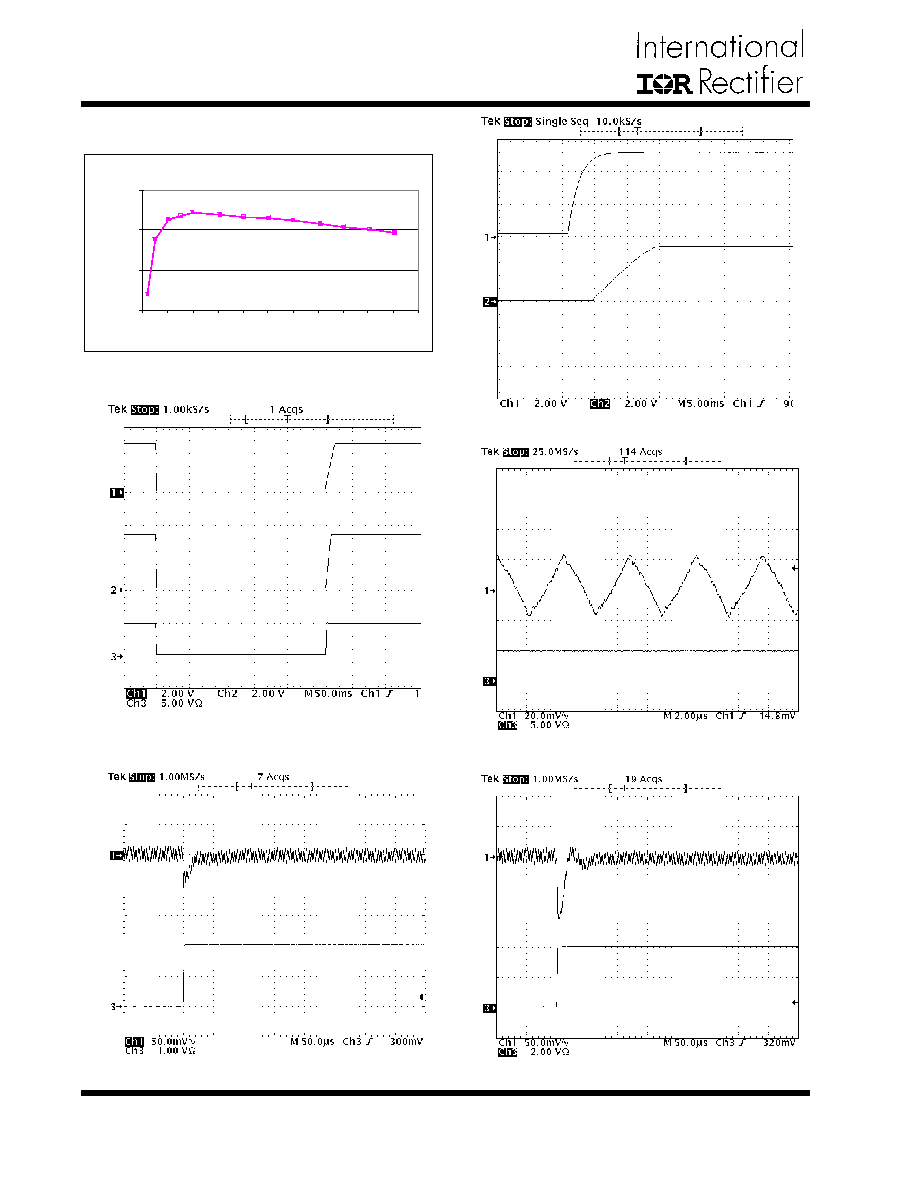
18
Rev. 2.8
05/10/04
IRU3037 / IRU3037A
www.irf.com
Figure 22 - Efficiency for IRU3037 Evaluation Board.
Figure 23 - Start-up time @ I
OUT
=5A.
Figure 24 - Shutdown the output by
pulling down the soft-start.
Figure 25 - 3.3V output voltage ripple @ I
OUT
=5A.
Figure 26 - Transient response @ I
OUT
= 0 to 2A.
Figure 27 - Transient response @ I
OUT
= 0 to 4A.
V
IN
=5.0V, V
OUT
=3.3V
70
80
90
100
0
1
2
3
4
5
6
7
8
9
10
11
Output Current (A)
Efficiency (%)
DEMO-BOARD WAVEFORMS
IRU3037
IRU3037
IRU3037
IRU3037
IRU3037
2A
0A
0A
4A
Vss
V
OUT
I
OUT
= 5V
V
IN
V
OUT

IRU3037 / IRU3037A
19
Rev. 2.8
03/10/03
www.irf.com
(F) TSSOP Package
8-Pin
SYMBOL
DESIG
A
B
C
D
E
F
G
H
J
K
L
M
N
O
P
Q
R
R1
MIN
4.30
0.19
2.90
---
0.85
0.05
0
8
0.50
0.09
0.09
NOM
4.40
---
3.00
---
0.90
---
---
0.60
---
---
0.20
8-PIN
NOTE: ALL MEASUREMENTS ARE IN MILLIMETERS.
MAX
4.50
0.30
3.10
1.10
0.95
0.15
8
8
0.75
---
---
0.65 BSC
6.40 BSC
1.00
1.00
12
8
REF
12
8
REF
1.00 REF
C
B
A
1.0 DIA
E
F
K
H
J
G
D
P
O
M
R
R1
N
L
Q
DETAIL A
DETAIL A
PIN NUMBER 1
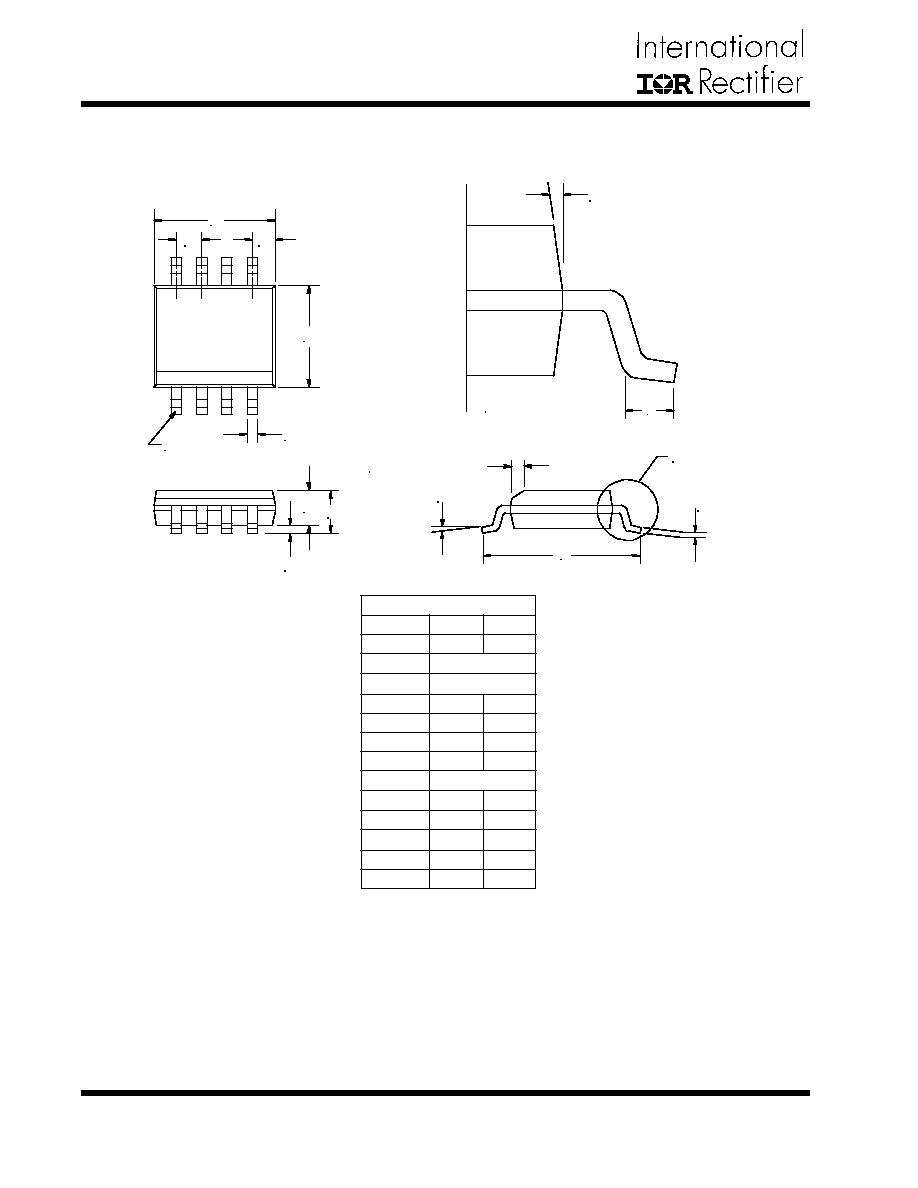
20
Rev. 2.8
05/10/04
IRU3037 / IRU3037A
www.irf.com
(S) SOIC Package
8-Pin Surface Mount, Narrow Body
SYMBOL
A
B
C
D
E
F
G
H
I
J
K
L
T
MIN
4.80
0.36
3.81
1.52
0.10
0.19
5.80
0
8
0.41
1.37
MAX
4.98
0.46
3.99
1.72
0.25
0.25
6.20
8
8
1.27
1.57
1.27 BSC
0.53 REF
7
8
BSC
8-PIN
NOTE: ALL MEASUREMENTS ARE IN MILLIMETERS.
PIN NO. 1
I
K
H
DETAIL-A
DETAIL-A
0.38
6
0.015 x 45
8
T
G
F
D
A
B
C
E
L
J

IRU3037 / IRU3037A
21
Rev. 2.8
03/10/03
www.irf.com
IR WORLD HEADQUARTERS: 233 Kansas St., El Segundo, California 90245, USA Tel: (310) 252-7105
TAC Fax: (310) 252-7903
Visit us at www.irf.com for sales contact information
Data and specifications subject to change without notice. 02/01
PKG
DESIG
F
S
PACKAGE
DESCRIPTION
TSSOP Plastic
SOIC, Narrow Body
PARTS
PER TUBE
100
95
PARTS
PER REEL
2500
2500
PACKAGE SHIPMENT METHOD
PIN
COUNT
8
8
T & R
Orientation
Fig A
Fig B
Feed Direction
Figure A
Feed Direction
Figure B
1
1
1
1
1
1




















